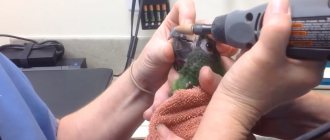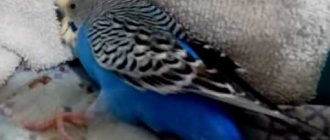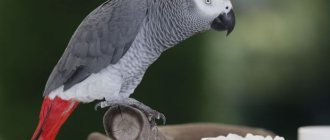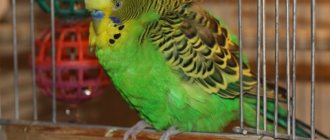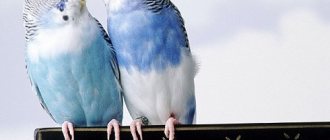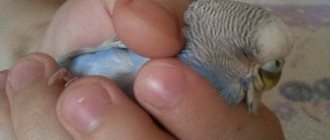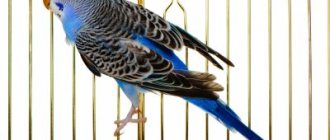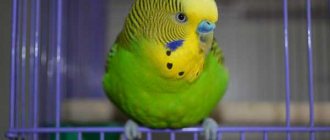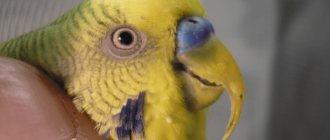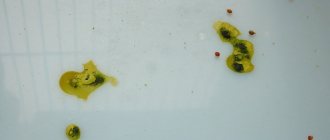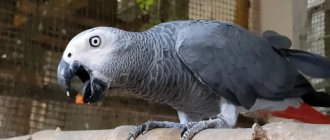04/20/2018 , Posted in Jaco Comments No comments
Parrot owners always closely monitor changes in the behavior of their pets. Often, the habit of grunting, crouching, and arching your back when you see a person can indicate serious problems. Such symptoms indicate the onset of sexual behavior, but in normal birds it is not accompanied so clearly. Therefore, it is necessary to figure out what to do if the parrot sneezes and groans.
Normal sexual desire must necessarily be triggered only in the presence of a female or another parrot. And if a parrot sneezes and groans in the presence of a person, this can mean one thing - he has problems with the psyche and hormonal system.
In science there is a special term - imprinting. It refers to the abnormal imprinting of a parrot on a person or other animal. The bird begins to develop a sexual attraction to an individual of a different kind. The reason for this is a violation of personality development. With timely assistance, the disease can be cured. However, this requires special efforts. What many owners don't do. They like this behavior of the pet.
It is important to note that for normal psychological development, the bird must be taken away from its parents no earlier than the chick reaches six months. If this happened much earlier, there could be serious problems with the animal's development.
Distinctive features
In order not to accidentally run into a sick bird, it is important to know about the main distinguishing features. You can notice them by their behavior. Usually the chick gets along well with other birds, feeds and plays independently. He doesn't need a person. And if the opposite happens and the chick is constantly in the arms of the owner, he cannot eat or have fun without him. It's worth wondering if everything is okay with him.
Gray Gray does not grunt immediately, but only when he reaches 8 months. By this moment, he understands that a person is vital to him. Many people perceive this as sympathy, but in reality the reasons are mental.
The parrot sneezes and groans: what to do
It is worth understanding that such an innocent deviation can cause serious harm to the pet. Therefore, having noticed the first violations, it is necessary to take measures to eliminate them. To do this, it is necessary to teach the bird commands that will help control the Gray's behavior. Let the bird fly more often and provide it with twig food. It is necessary to load it with maximum load.
If a Gray Gray grunts and ignores the problem, the bird will become more aggressive and uncontrollable. Soon the owner will definitely get tired of this, and he will decide to sell it or give it to friends.
Often a person acquires an already sick pet and does not even know it. Long-term treatment, appropriate care and a huge amount of attention lead to the fact that the parrot gradually groans. And after a while it begins to actively dance in the presence of a person. The owner is sure that everything is fine with the bird - she is active and cheerful, but in practice everything is not at all so harmless.
The thing is that while in the store he was surrounded by bad conditions, but after the purchase everything changes seriously. But poor living conditions often cause the development of chronic diseases. It is simply impossible to identify them immediately after purchase. The reason for this is their hidden flow. Even x-rays often do not provide accurate information on the condition of internal organs. However, having left unfavorable conditions, the disease begins to progress.
It turns out that proper nutrition and a change of cramped cage gradually revive the bird. But at the same time, antibodies that have been dormant for a long time begin to be produced. Their appearance leads to the production of antibodies and increased inflammatory processes. The pet begins to suffer severe pain. Often he begins to pluck his own feathers and becomes too active. Visually reviving a pet in practice means its severe physical deviations, which can lead to death.
Therefore, if a Gray Gray grunts, you cannot ignore this behavior. It marks the beginning of the progression of the disease. You need to seek professional help as soon as possible. During therapy, the owner must maximize the activity of the bird and increase the variety of feed. A healthy bird only behaves excitedly in the presence of another bird. All other cases mean only one thing: the bird needs treatment.
Owners of gray parrots (we are talking about both nursing chicks and adult birds) are often frightened by the unusual behavior of their pets: when a person appears nearby, the parrot begins to groan, crouches, shakes its tail, and arches its back. This behavior can be observed in both males and females.
This is sexual behavior for Grays, but it is not normal sexual behavior.
Video: Typical abnormal sexual behavior of a female Red-tailed Gray Gray (Psittacus erithacus). This is my patient who completed a course of treatment for aspergillosis and mycobacteriosis (the treatment lasted several years; the infections were dealt with, but complications caused by the diseases still persist).
Normal sexual behavior occurs in a parrot only in the presence of another parrot. The sexual behavior that will be discussed in this article is a consequence of disruption of the hormonal system and psyche of the parrot. It is caused by different reasons in different birds, but it manifests itself in a similar way. Groaning in this case is a syndrome.
Imprinting is the imprinting of a person, any other animal or object as a sexual partner. Imprinting is a disorder in the development of a parrot's personality. For parrots, such “human imprinting” may not become irreversible if the owner makes efforts to restore the bird’s normal behavior. But parrot owners often specifically reinforce this behavior of the bird because they like it.
When you see a photo or video in which parrots willingly kiss a person, sleep in a bed, when African Grays allow themselves to be wrapped in blankets or towels, this behavior of a bird is an example of impaired development of avian personality.
Let's return to the situation with nursed Gray Gray chicks.
Let me remind you that chicks of Grays, Amazovs, cockatoos, macaws, as well as other medium and large parrots can be taken from their parent birds at the age of at least 6 months. And only after the chick has developed normal bird behavior; after the chick communicates with adult birds.
Video of budgerigars tweeting
Today, there are a lot of videos and audio recordings on the Internet in which budgerigars sing their songs.
List of some Internet sites that provide video and audio files of budgerigars singing:
- https://www. youtube. com/watch? v = KB 1 xKkqwzpI
- http://plus - music. org / video /chirping+budgies+parrots
- http://www. papuga. in. ua / chirikane - volnistyh - popugaev - slushat - online . html
- http://ysatik. com / ptici / soderzhanie - i - uhod - za - popugayami / kak - poyut - volnistye -7328/
How to distinguish normal behavior of a chick from abnormal?
A normal chick nursed by a Gray or another parrot grows up with other chicks, sees adult birds, sees a person, is not afraid of a person, but is slightly wary of a person. A healthy chick grows self-sufficient, plays with toys independently, masters new food, explores the room by actively flying, and does not scream when a person leaves the room. In other words, it does not need human hands and attention.
Groaning in fosterlings can appear at the age of 4-8 months. This is due to the fact that hatchlings become very attached to humans due to the fact that humans replace adult birds with them and act as a model of behavior for the chick.
In this video, the Gray is a fosterling that was acquired at too early an age. It should be noted that this chick was acquired infected with circovirus, staphylococcal infection and aspergillosis. In the video, you can clearly hear the grunting, it is clear that the bird has uncharacteristic behavior, it tries to caress the person, which is perceived as affection. Fortunately, the owners of this chick immediately contacted a veterinarian and the identified infections are being treated.
Among the huge number of psychological traumas that a young parrot develops, there are also purely physiological problems: the reared parrots move very little; the most they have for movement is a play stand, room or cage full of toys. In nature, parrot chicks fly a lot after their parents, explore new food, territory, i.e. They lead a very active lifestyle, exploring the world around them. A man-fed Gray Gray chick is a cute goofball who suddenly begins to masturbate.
Why doesn't my budgie sleep at night?
A more alarming signal is lack of sleep at night. If the environment is quiet and dark, and the parrot is making noise all the time or making strange sounds, then you need to act urgently. First, you should make sure that the bird does not have a bruise or fracture. It is possible that a budgerigar falls from its perch due to weakened legs and loss of balance. In this case, the wound is treated or a splint is applied if there is a fracture. But it’s better to remove the perch and swing, otherwise the parrot will climb onto it by inertia and only make the situation worse.
What should the owner of a Gray Gray chick do if the parrot starts groaning?
You need to do exactly what should have been done back when the chick was 2-3 months old: teach the chick commands, targeting and other techniques that allow you to control the behavior of the bird, provoke active flights at least within the room. The simplest option is to feed the chick only after it flies in for food (or, at first, comes). It is necessary to provide the fledgling with a large amount of branch food, large fruits, nuts, pine and spruce cones.
The owner's primary task is to load the parrot with physical activity. The Gray, like any other parrot, has to chew a lot!
If measures are not taken to restore the bird's personality in the chick, the Gray will become more and more aggressive and uncontrollable. As a rule, the life of such a bird looks like this: in 2-3 years the first owner changes and a leapfrog of resales begins (ads on Avito, in bird publics, on forums). At 3-5 years old, if the bird is lucky, it goes to a person who wants to improve the bird's living conditions and does everything as it should in terms of feeding (this is the easiest part in ensuring the correct care of Grays and other parrots). But after several months, usually 6-9, the groaning suddenly appears again.
However, now this is a completely different story and has different reasons, although visually it manifests itself in the same way - grunting, squatting, biting, sometimes very aggressive.
Deterioration of the parrot's condition after purchase
So, let’s move on to the “classic” situation: an adult gray parrot, rescued from terrible conditions of detention, where he lived for years in a cramped, dirty cage and ate only seeds, finds himself in good conditions.
The title photo shows a young sick gray parrot. How can you tell if this Gray is sick? Look at the condition of the plumage - it is loose, unevenly molted, down is knocked out in places, the wings are drooping, the back is “humped” - these are nonspecific signs of the disease, and they can be caused by a variety of infectious pathogens. Most buyers do not even suspect that such signs indicate that the bird has health problems, and, as a rule, require long-term treatment.
The new owner adjusts the diet, examines, carries out a course of treatment and calms down, because everything is already fine: gradually the parrot begins to eat more and more fruits, vegetables and other normal food for a gray parrot, becomes noticeably more active, begins to vocalize more often, and one day begins to groan and “dance” "in the presence of a person. The owner perceives the bird’s manifestation of sexual behavior calmly, because everything has already been done as it should, the bird is in a good mood, it is active. But after a couple of months, the bird may suddenly die.
What is the reason for the sudden death of the bird?
Why did a parrot live for years in bad conditions, but when it found good conditions, it died?
The fact is that when a bird lives in poor conditions, the bird’s immune system cannot give an adequate response to infectious agents and parasites. In such conditions, the weakest birds die very quickly, and those that survive live with chronic diseases and parasites for years. As a rule, birds are affected by diseases caused by enterobacteria, staphylococci, enterococci, mycobacteria, aspergillus - everything that a bird can become infected with from humans, and which it cannot resist in poor housing conditions.
A weak immune response means that pathogens easily colonize internal organs, bone marrow, and joints. The bird’s body fights bacteria and fungi to the best of its ability, but the bird does not have the resources for a full humoral response; antibodies are either not produced at all or are produced in very small quantities, because, for example, there is simply not enough protein in the diet. Often this situation ends in the death of birds, but those who survive the first weeks of deteriorating living conditions can then be sick for years, and for years be carriers of infections, helminths or protozoan parasites.
In addition, bird pus is hard. The inflammation occurs as granulomatous. This means that the source of inflammation is surrounded by a thick capsule of dead tissue (pus). Therefore, many infectious agents remain for years inside granulomas - there they are protected from antibiotics, from antibodies, from macrophages.
When infections enter the carrier stage, the pathogen is either not released into the environment or is released from time to time and in very small quantities. And it is for this reason that the first test results, which are done immediately after purchasing the bird, may be negative.
— X-rays of such parrots may not reveal significant abnormalities, with the exception of general degeneration of the internal organs (small heart and liver, slightly increased density of the kidneys and air sacs). — An endoscopic examination may not reveal any significant abnormalities, except that the walls of the air sacs may be slightly thicker than they should be normally. — Tests that measure antibody titer may give a negative result, because the active stage of inflammation has long passed. — PCR tests may be negative, because pathogens of chronic infections are not constantly released into the environment.
Example: with the development of a chronic form of bone tuberculosis, mycobacteria practically do not enter the bloodstream, or into the intestinal lumen, or into the lungs, and therefore it is often impossible to determine their presence in birds. Bone changes can be seen on an x-ray, but due to negative test results, the cause of the bone changes remains unidentified. In such a situation, the veterinarian will tell you that nothing was found / the bird is not sick / or will prescribe a short course of preventive treatment. As a result, the owner is calm.
The parrot begins to “come to its senses.” This means that the bird’s body begins to produce antibodies (remember that previously the bird might not have had enough protein in its diet to synthesize antibodies for protection). Due to the production of antibodies, inflammatory reactions intensify wherever they were previously barely warm, and primarily in the joints. Pain appears. Because of the pain, the activity that the bird had already acquired by this time decreases, and the bird suddenly begins to pluck itself. (This is one of the reasons for the myth of “stress causing plucking in a parrot after moving to a new home”). The activation of inflammatory reactions is also associated with the process of destruction of granulomas, which previously isolated bacteria and fungi within themselves. Granulomas in birds do not calcify completely; they only temporarily isolate the infection. And when the walls of the granuloma (pus) are destroyed by activated macrophages, the pathogens enter the blood again and therefore a relapse of the infection develops.
This is always unexpected for the bird owner: after all, outwardly everything was going well, everything was done as needed, and suddenly - a decrease in activity, sudden death, self-plucking.
So what does grunting and sexual behavior have to do with it? And given that such sexual behavior is a “marker” of exacerbation of diseases, it is time to fully examine the bird again. Groaning, squatting and flapping wings without a pair are the earliest signs of exacerbation of the Gray's disease.
Is it necessary to install a nest box if the parrot begins to exhibit sexual behavior?
It is important to understand and remember: the groaning of a female or male Gray does not mean at all that it is time for her/him to breed and it is time to set up a nest box and look for a male/female. Groaning (a manifestation of sexual behavior) may mean that the female, for example, is developing hepatitis. Those. female sex hormones are produced in normal quantities, but with the development of liver failure, the hormones are not metabolized in the liver and this leads to their increased levels in the blood. Liver dysfunction occurs due to inflammation caused by E. coli or another infection that affects the liver (tuberculosis, aspergillosis, psittacosis, salmonellosis). Having placed such a female for nesting, it is possible to obtain a full clutch, but the probability of the female dying during the process of oviposition is very high; and, importantly, the chicks will be infected with the infection while still inside the egg and, therefore, weakened initially.
In general, chronic egg laying (as a consequence of impaired metabolism and developed diseases) is a problem for all sick parrots. Completely hairless female macaws or plucked cockatoos, which continuously nest and mate, can be observed frequently.
What should you do if an adult Gray Coat begins to groan?
If a solitary gray parrot suddenly begins to exhibit sexual behavior, the parrot needs to be examined. In addition, you need to maximize the activity of the bird, increase the variety of food available to the bird - this will help restore both the psyche and health of the parrot.
Remember, a healthy parrot exhibits sexual behavior only in pairs.
Male and female Red-tailed Grays. The male is on the left. Pay attention to what the plumage of healthy parrots should look like. Owner Tikhonova Lyudmila.
The offspring of Amazons, Macaws, and Alexandrine parrots are less likely to imprint humans. The reasons for this are not known; It is possible that Grays are more popular as pets than other parrot species, and therefore little is known about this problem in other nursery parrots.
Parrots are quite loud birds. They love to sing, imitate people's voices and the sounds of the world around them. Sometimes the intonation and strength of their voice is frightening. When your pet starts to grunt constantly, it looks suspicious. There are several main reasons for this behavior, some of which require owner intervention. Why does the parrot make these sounds?
Other strange habits of parrots
Many actions in a pet's behavior can surprise new breeders. The most common oddities are:
If the owner has heard creaking sounds from a bird's house and noticed that the bird is sitting with its feathers fluffed up and its beak creaking happily, there is no need to give in to excitement. This is what a pet happy with life looks like. This means that the parrot loves its owner with all its heart. You just need to try to answer him at the same price. Then one day you too will be able to hear this curious sound, thanks to which any breeder will experience incomparable happiness.
Sexual behavior
In this case, the parrot groans when a member of the opposite sex is next to it. At the same time, other behavioral features are observed: the bird can arch its back, shake its tail or squat. This is normal and indicates that the feathered pet is in good health.
The parrot grunts especially actively during the mating season. At this time, other rituals are observed in the couple: birds preen each other’s feathers, lightly pinch their partner, they can kiss and feed their dear friend. If suitable conditions are created for exotic pets at this time, they will begin to reproduce.
Sometimes sexual behavior with grunting occurs when there are no other parrots nearby, but a human is nearby. This is considered a violation of the bird's mental state. It is necessary to adjust the behavior of the winged friend. It is necessary to give the bird the opportunity to often fly around the room, load it with physical activity and conduct developmental activities. Let the parrot play with its toys and nibble on vegetables or fruits.
What should you never do?
Wrong behavior of the owner can only cause harm. Here's what you're prohibited from doing:
- It is not allowed to shout at a budgie;
- It is not recommended to hit the cage with your hand;
- It is forbidden to spray the parrot with water.
Otherwise, the stress will be aggravated and the parrot's screaming will continue. The best way to do this is to add treats and spend a lot of time interacting with your wavy to reward good behavior.
You can try to redirect the energy of the wavy to something more useful. For example, he can be taught to pronounce any word or sentence. If he behaves well, it is better to reward him with any treat or give him a toy.
You need to spend a lot of time with your bird. This is the key to his normal behavior. However, in some cases the owner is not able to spend a long time with him. Then it’s better to add some sounds to your home that indicate his presence. First you can turn on the radio, and then the TV and alternate between them. If the owner is not far away, but is busy, then you can free him: let him fly around the room!
A way to communicate with the owner or the opportunity to “talk”
Parrots are intelligent birds. They imitate the various voices of nature, sing and repeat the sounds of human speech if they are trained to do so. Along with this, exotic pets may grind, chirp, squeak, mumble, chirp and scream when communicating with their owner.
Some species of birds simply like to grunt. With different tones in their voices and different volumes, such sounds are made for pleasure by many popular parrots: cockatiels, cockatoos, budgies, Amazons, macaws and grays. All that remains is to simply enjoy communicating with your colorful pet friend, talking to him and showing your affection by stroking or scratching him. In this case, it is better to avoid touching the abdomen and back, since in this case the bird may perceive the person as a sexual partner. This is especially true for large breeds of parrots.
The budgerigar sleeps all the time during the day!
Daytime sleep is considered the norm for birds, as ornithologists say. Birds can rest after a hearty lunch or out of boredom. Sometimes owners feel that their parrot sleeps too much. Should I panic or is this normal? First you need to understand what time the bird goes to bed at night.
There are known cases when, due to the owner’s wakefulness, a feathered pet does not sleep. A parrot needs silence and darkness to sleep soundly. Flickering from a TV or music that puts a person to sleep has a different effect on a bird. The parrot does not sleep half the night, and then rests all day. If such a pet appears in the house, then its needs cannot be ignored. You need to take care of your parrot and only then will he be cheerful and cheerful. Do not forget that budgies are depressive creatures. If they are not allowed to sleep, there will be stress.
When should you worry? When a parrot sleeps at night and is always in a sleepy state during the day. In this case, it is worth taking a closer look at its plumage and how the bird eats. If the appetite has disappeared, and feathers are visible around the cage, then the parrot may be molting. During this period, you need to give the bird special vitamins and it is better to keep it busy with games, but it is better to arrange flights.
But liquid diarrhea of an unnatural color, vomiting and unkempt feathers indicate illness. It could be simple food poisoning or a bruise, but sometimes these are the initial signs of serious illnesses. In this case, the bird should be shown to a veterinarian and may have to undergo tests. Only a professional doctor is able to make a competent diagnosis and prescribe the necessary medications.
Disease
Most often, it is the disease that becomes the main reason that the parrot constantly groans. With a number of serious health problems, the bird can make such sounds. In this case, grunting will not be the only sign of a problem. Depending on the disease, other abnormalities in behavior or appearance appear.
- Respiratory diseases.
When you have a cold, you may experience coughing, sneezing, or runny nose along with groaning. Mucus accumulates in the nasal openings. The cause of ill health may be too cold water in the drinking bowl, low temperature in the room with the parrot, drafts or contact with a sick bird. A sick pet is placed in a warm room, the beak is cleaned if necessary, and warmed up with lamps. If you do not seek help from a veterinarian, complications are possible.
Groaning may be an additional sign of bronchopneumonia, rhinitis, bronchitis or sinusitis.
- Cerebellar hypertrophy.
The disease occurs more often in aging birds. Damages appear that partially block the airways. In this case, tumors sometimes appear in the oral cavity. They change the voice of the bird, which begins to groan.
- Nervous system diseases
With various mental disorders and seizures, the bird may make abnormal sounds, including strange grunting. In this case, changes in behavior are observed. For example, a parrot may scream almost continuously, hit the walls of the cage, or fall from its perch.
- Malfunctions of internal organs.
The pancreas and liver suffer if the parrot is not fed properly. In this case, along with grunting, digestive disorders occur. Constipation and diarrhea are possible, and appetite worsens.
- Cardiovascular diseases.
The parrot constantly groans, and at the same time other, often quite serious, abnormalities appear. The bird becomes lethargic, refuses to eat, suffers from shortness of breath, and sometimes swelling or blueness of the limbs occurs. If you suspect an illness, you should contact a veterinary clinic early in order to help your beloved pet in time and prevent the development of serious complications.
A pet grunting every now and then is usually not a sign of a serious problem, but simply the bird's way of communicating. When a parrot groans constantly and for a long time, a health problem should be ruled out. To do this, you need to pay attention to other changes in the appearance or character of the parrot.
A healthy parrot is very active. He often moves around the cage, plays and chirps. Any changes in its behavior indicate that the parrot is experiencing discomfort. Shivering in itself is not dangerous to the bird's health. It happens for a reason. If the bird sits silently in one place and shakes slightly, you must also pay attention to the appearance and behavior of the parrot. Trembling may be accompanied by the following symptoms:
- drowsiness;
- apathy;
- lack of appetite;
- the bird ruffled its feathers;
- eyes closed;
- disheveled appearance.
Unusual behavior and accompanying signs should never be ignored. The first step is to find out the cause and eliminate it as soon as possible.
If trembling occurs due to illness in your parrot, you should immediately contact a specialist.
It is also worth inspecting the cage and paying attention to bird droppings. Its absence, or, conversely, an excessive amount, changes in color, smell, structure, all this may indicate symptoms of the disease.
Diseases of budgies
ORNITHOLOGY LIBRARY NEW BOOKS SPECIES OF BIRDS LINKS SITE MAP ABOUT THE SITEBudgerigars kept in cages and aviaries are highly resistant to various diseases. Despite this, they can still get sick from diseases that are observed in all birds living in the wild. Recently, we have had to deal with special diseases caused by unfavorable living conditions for budgerigars, and these diseases are rarely observed in birds living in the wild.
It is not easy to recognize diseases, especially in their initial stages, so fanciers should carefully monitor the behavior of their birds and record the changes occurring in them, because this data can serve as the basis for determining the correct diagnosis.
Many lovers who keep budgerigars try to independently treat sick birds with home remedies and only after trying a number of medications on them do they seek help from a doctor. Meanwhile, the hidden disease is progressing and its exact diagnosis is difficult to determine. Such irresponsible actions are not justified in any way, and every fan, before feeding birds with various medicines, should think about the fact that an adult budgerigar weighs 2000 times less than a person, therefore, in order to avoid poisoning, birds need medicines intended for humans give in much smaller doses.
The first color drawing of a budgerigar (after J. Gould - 'Birds of Australia')
Signs of a serious illness in budgies appear within one day. The birds are lethargic, inactive, sit indifferently on the perch, rest more, and sleep often. At the onset of the disease, birds lose their voice, and “talking” budgies stop “talking.” Signs of illness are also visible on the plumage; birds sit in one place for a long time with ruffled feathers; those suffering from chronic diseases have dull and brittle feathers. Breathing is difficult, birds make hoarse, plaintive sounds.
The owner should carefully examine his birds, paying special attention to the undertail of healthy birds - it is clean, without pieces of droppings. The eyes should be clear, clean, alive, without mucus.
Urine and droppings tests are of great importance. Budgerigars' discharge has its own shape, with urine forming a white cap on top of the droppings. The ratio of urine and droppings is also very important: an increase in the amount of urine indicates impaired renal function, and urine spilled around the droppings indicates improper processing of fluid in the kidneys. Even experienced fanciers often confuse this condition in birds with the appearance of diarrhea; they treat birds for diarrhea and, of course, to no avail.
Vomiting in budgies can be a consequence of disorders of the digestive tract, but sometimes, for example, in single males it is an imitation of sexual activity.
It is also necessary to periodically examine the condition of the horny covering of the beak: in healthy birds it is always smooth, clean, without cracks or delaminations. In the same way, the horny scales on the legs of a bird are smooth, shiny, and thin. Typically, a healthy budgie rests on one leg. Constantly standing on a perch on two legs while swaying or shaking the body is also a signal of an impending illness.
An experienced amateur can note the onset of the disease by many subtle deviations from the norm. It is very important to detect signs of bird diseases in the very environment in which they constantly live, since placing sick birds in another room usually leads to a new outbreak of the disease.
Sick budgies are usually given sedatives, and in doses appropriate to their size and weight. For mild forms of the disease, the medicine is added to the water or to the birds’ favorite food. The owner should always know what is a delicacy for his pets, and cultivate in his birds a preference for any one type of food. This will greatly facilitate the administration of medications if necessary. It is undesirable to catch birds for the purpose of forcibly giving them medicine, as this further aggravates their stressful state.
When instilling medicine into a bird's beak, you need to act very carefully, pour drops into the open oral cavity gradually, in small portions. Otherwise, strong defensive reactions are possible, which can ultimately lead to the death of the budgie. The bird is carefully picked up, the open beak is fixed with two fingers, and medicine is dripped into the resulting gap, monitoring by the movement of the tongue how the bird swallows it.
In some cases, sick birds are given medicine using a probe into the cavity of the crop or given an intramuscular injection. These procedures are performed by a veterinarian.
There are a number of diseases that budgerigars suffer from. Many of these can be prevented by keeping birds in good sanitary conditions. One of the main conditions for maintaining the health of budgies is keeping them separate from domestic and free birds and other animals. A great danger to budgies are wild birds and rodents, whose droppings often end up in feeders and drinkers and cause infectious diseases.
One of the main factors preventing the occurrence of diseases is proper and nutritious nutrition for budgies. Their food should be varied, standardized and contain the required amount of vitamins. An overdose of nutrients in itself can lead to serious health problems for budgies. This also applies to the use of various fortified feeds, which are given to birds not constantly, but only from time to time.
Of the many diseases, the most common among budgies is psittacosis.
- a disease of parrots. The disease is caused by chlamydobacteria, which were previously considered viruses. It is known that psittacosis is a widespread disease among various species of birds living in the wild. Parrots can become infected by carrying the infection from a sick bird or by being in a contaminated environment in which a sick bird lived. The disease is even transmitted through the droppings of sick birds. Often the disease is very severe, and within a few days a huge number of birds die. Birds experience swelling of the connective membrane of the eyes, copious discharge from the cloaca, and sometimes a severe runny nose. Loss of appetite and catastrophic loss of strength sets in. Birds that survive this stage of the disease become chronically ill, and the symptoms of the disease do not appear as clearly. But since birds constantly carry a source of disease in their bodies, the slightest overload or stressful situation (during transportation, at an exhibition, etc.), overheating, or a minor cold causes the disease to worsen. At this time, there is a danger of the disease spreading and infecting healthy birds. In any case, chronically ill birds are characterized by slow growth, they gradually lose strength and finally die. Autopsy of sick birds reveals severe necrosis of some areas of the liver and a greatly enlarged spleen. The lungs of budgerigars are less susceptible to disease. Due to the fact that until recently psittacosis was considered a dangerous disease (especially for humans), during outbreaks of this disease entire flocks of budgerigars were destroyed. With the introduction of antibiotics (tetracycline group) into medical practice, the number of psittacosis diseases in birds has decreased. This was largely facilitated by the restriction on the introduction of free-living budgerigars. Mass events, such as, for example, bird exhibitions, when many cages with birds of different species are placed in relatively small rooms, also pose a certain risk to healthy birds. At such moments, the risk of infection or infection is very high. Therefore, before sending birds to an exhibition, they undergo a thorough veterinary examination, and after returning, exhibition birds must be quarantined for some time separately from other birds.
Salmonella
- a disease that often occurs in flocks of budgies is caused by intestinal rod-shaped bacteria - salmonella. Birds become infected from one another through contaminated excretions of sick birds, as well as through contaminated food and drinking water. The disease progresses very quickly, and the bird dies due to dehydration due to severe diarrhea. If the disease becomes chronic, the main symptoms are swelling of the joints and muscles, growth inhibition, general weakness, drowsiness, and lethargy. Birds chronically sick with salmonellosis become carriers of the disease. Infection is detected by bacteriological analysis of droppings or by autopsy of the bird. Treatment of the disease in most cases does not give positive results. There may be some hope for success if the disease is detected at an early stage and with intensive treatment. But even then the danger of spreading the disease is too great. Given the likelihood of transmitting the disease to humans, treatment of birds must be carried out in strict accordance with the measures provided for in veterinary instructions and under the direct supervision of a veterinarian. One of the ways to prevent the disease in case of its threat is thorough tests, checks of food and water, as well as temporary isolation of new birds, their laboratory examination at veterinary stations before release into the general flock.
Like all species, budgerigars are susceptible to attack by a range of intestinal parasites
, of which
roundworms
.
These are roundworms that parasitize the small intestines of birds. Budgerigars usually become infected with the disease through food contaminated with droppings from sick domestic or wild birds. Sick budgies experience alternating alternation of diarrhea and constipation, loss of appetite, drowsiness, painful reaction to touch, and rapid weight loss. A timely detected disease can be treated with medications ( See: Bessarabov B.F. Diseases of songbirds and ornamental birds. - M.: Rosselkhozizdat, 1980. - Ed. note
). Treatment is carried out in parallel with such measures as thorough cleaning and disinfection of cages, enclosures, and care tools. All equipment is washed with hot water with the addition of soda or disinfectants and rinsed several times with clean water. Protection against infection is the same as for salmonellosis in birds.
From external parasites
The danger for budgies is posed by small parasites - mites (Knemidocoptes pilae), which cause a skin disease - scabies. The disease primarily affects the beak, eyebrows, head and legs. The horny substance of the beak looks as if it is perforated with numerous depressions, the skin around the beak and eyes becomes inflamed and covered with a lumpy mass. The same thing is observed on the fingers, where the horny cover grows and the scales reach enormous sizes. The disease sometimes spreads to the feathered parts of the bird's body (around the cloaca). When the disease is advanced, the birds breathe heavily and become lethargic. But this disease can be cured. The non-feathered parts of the body are usually lubricated with an oil solution (the Czechoslovak medicinal drug “Szabitol-Spofa”), and the feathered parts are well sprayed with the aerosol preparation “Arpalit”. The duration of treatment is one week. After this time, the formed layer of horny crust should be removed from the birds (especially around the beak), all grooming tools should be thoroughly washed and boiled, and the cage or enclosure should be treated with the Arpalit disinfectant (1 m2 for 10 s).
Of the non-contagious diseases, budgies most often experience an enlarged thyroid gland.
. The cause of the disease is not entirely clear, but may be due to a combination of several factors. The most pronounced symptom of the disease is fatigue; birds lose the ability to fly. At first, breathing becomes difficult after physical activity, and at the end of the illness - even at rest. Shortness of breath often leads to misdiagnosis, and birds are treated for pneumonia or upper respiratory tract inflammation. If birds are found to have an enlarged thyroid gland due to iodine deficiency, it must be added to the water or food. In such cases, birds can be helped quickly and easily. However, recently this disease has been increasingly observed in budgies, whose food is systematically supplemented with various drugs, in particular fortified millet as the only type of food. When examining birds with respiratory failure, care must be taken, since with the slightest sudden movement - pressing on the crop or changing the position of the bird - they suddenly die. Therefore, caring for birds—shortening claws and beaks—should be postponed until they are completely recovered.
Budgerigars often develop gout. The disease is caused by overfeeding these birds with homemade food that is not typical for them. Yet the causes of this disease in small birds are not entirely clear. It can be assumed that we are talking about metabolic disorders and a simultaneous change in kidney function. This proposal is based on the fact that excess salts accumulate in the joints.
Signs of the disease include the appearance of nodules around the joints and tendons on the birds' legs. The nodules are white with reddened veins and swelling, and they apparently cause the birds severe pain. Budgies with gout are depressed, they get tired quickly and cannot stand on their feet. These external signs are a reflection of internal, more serious disorders of the kidneys or other internal organs, in which large amounts of uric acid salts accumulate. In the initial stage of the disease, birds experience alternating lethargy and vigor, lack of appetite and its sudden appearance. Sick birds drink a lot. During an exacerbation of the disease, bird droppings are liquid and abundant. And later severe diarrhea begins. In this condition, birds without special treatment can die within three to four days (counting from the first day of the appearance of nodules on the legs). But in some cases the disease becomes chronic.
During treatment, it is necessary to remove the formed nodules on the birds’ legs. To do this, you need to pierce the nodule with a disinfected needle and squeeze out the liquid. Relief occurs immediately, although the possibility of new nodules cannot be ruled out. Such home treatment is usually supplemented by giving the birds medications that help dissolve uric acid salts. In parallel with this, animal proteins and vitamin preparations are excluded from the birds’ diet. Apparently, excessive doses of vitamin A lead to a deterioration in the physical condition of budgerigars. Experience shows that the hope of curing birds from gout is not without foundation.
Serious damage to the plumage of budgerigars is permanent molting. This disease is widespread among budgies, which are kept in too warm apartments all year round. In this case, we are not talking about a specific disease, but simply about the bird’s adaptation to a constant warm and dry environment. For therapeutic and preventive purposes, we can only recommend changing the environment and maintaining an average duration of sleep in a cool room.
Plucking the feathers of budgerigars often accompanies scabies and indicates that the birds are infected with skin parasites. However, damage to the skin and feathers caused by fungus may also be the cause. Treatment is recommended only after sick birds have been examined by a veterinarian. Oily liquids are not recommended for lubricating feathers, as budgies pluck lubricated feathers.
Many fanciers are interested in a feather disease in budgies called French molt. It must be said that at present this unpleasant feather damage cannot be treated. In young birds, soon after their first departure from the nests or just before departure, the feathers of their wings or tail rapidly fall out, and new ones either do not grow or grow with defects. In any case, these new feathers are shortened or underdeveloped. Typically, the shafts of such feathers contain coagulated blood, indicating that the feathers were still “alive” at the time of shedding. An analysis of the blood of such birds shows that there is a sharp decrease in the number of red blood cells in the blood, and a study of the bone marrow at the same time indicates an increased activity of substances that produce red blood cells. Many researchers believe that this situation is typical when there is an excess of vitamin A in the body and a simultaneous lack of vitamins E and K. The results of numerous observations and studies allow us to conclude that French molt is not:
normal infection with bacteria, fungi or viruses;
a consequence of parasite attack;
lack of vitamins, minerals, amino acids, fats and carbohydrates;
ordinary hereditary factor;
a common hormone deficiency or a consequence of a hormonal disorder;
reaction to environmental factors (light, etc.).
In parallel with this, factors were identified whose influence undoubtedly stimulates French molt:
stressful conditions as a result of crowding, premature laying, unseasonal reproduction;
selection of budgerigars for the purpose of obtaining exhibition specimens;
unfavorable sanitary and hygienic conditions during breeding;
infectious diseases, environmental and nutritional factors not in themselves, but only as factors that aggravate stress;
pairs of parents who have had French molt are more likely to produce offspring with this disease;
feed compositions containing excessive amounts of fish oil or preparations with vitamin A sharply increase the number of sick birds.
Inflammation of the goiter is one of the relatively common diseases of single males. Most often, the disease occurs after the bird burps, and it then pecks its burp. However, due to poor-quality food - old moldy grains, stale egg food - pairs of parrots can also get inflammation of the goiter. In a sick bird, there is a significant increase in the crop, filling it with a watery mass, from which the bird tries to free itself. Thickening of the goiter walls is noticeable to the touch; the contents of the goiter are foamy with a disgusting odor. The bird suffers from diarrhea and quickly loses strength. The disease is often caused by pathogenic microbes or fermentative fungi. Sometimes the cause of the disease may be the bird swallowing indigestible objects (pieces of cotton wool, fabric, plastic, etc.), which prevent the passage of food into the stomach. Various medications can be used to treat the disease. A sick bird needs qualified treatment, so you should seek help from a veterinarian as soon as possible. But first of all, it is necessary to regulate the proper nutrition of the sick bird.
Many budgies suffer from chronic enlargement of the goiter.
when the cavity of the crop is overfilled with food. Upon examination, it turns out that the walls of the goiter are thinning, and the food entering it hardens. Chronic expansion of the crop spoils the appearance of a budgerigar, which in normal condition can accept an unlimited amount of food, but in a sick bird, food is retained in the crop, the walls of which become flabby, causing the bird to quickly lose strength. In such cases, even surgical intervention leaves no hope for recovery.
Diarrhea
in budgies it is one of the most common causes of their death. Diarrhea in birds is more a consequence of the disease, rather than the disease itself. Diarrhea is not always a consequence of intestinal inflammation, as even experienced amateurs mistakenly believe. Knowing the causes of diarrhea in birds is of great importance in choosing appropriate medications and treatments. In addition, treating any disease that causes diarrhea, such as in mammals, can have catastrophic consequences in birds. Only when we are sure that diarrhea is caused by an incorrect diet do we have the right to treat a sick bird on our own, without resorting to the help of a veterinarian, that is, in the case when the bird, although it has liquid droppings, is mobile and not loses appetite. Birds usually recover quickly if they are given crushed activated carbon, fruit tree branches with bark, or small doses of phthalazole for several days. In this case, green food such as lettuce, cabbage, plantain, etc. should be completely excluded from the diet. In case of prolonged diarrhea, when the birds continue to experience drowsiness, lethargy, and lack of appetite, they must be sent for examination to a veterinary station. In this case, you need to take pieces of droppings with you for laboratory tests.
The reason for the retention of an egg in females may be a history of inflammation of the oviduct, a cold during oviposition, when the female cannot lay an egg, and if she lays it, the egg turns out to be of an ugly shape or abnormal size with an excessively fragile shell. Sick females take a horizontal position, stretch their heads forward and breathe heavily.
A sick female is usually placed in a room with an air temperature of 30° - 32° C, under the influence of heat her spasms stop, and she finally lays an egg. If the egg is retained in the cloaca or in the lower part of the oviduct, the bird needs help: with a swab dipped in liquid paraffin, massage the areas around the cloaca with light circular movements, gently pressing on the abdominal cavity. This helps the female squeeze out the egg. It is very important not to crush the egg. If these measures do not help, you should contact your veterinarian. But under no circumstances should you crush the eggs - this will lead to the death of the bird.
Budgerigars, especially older ones, often develop tumors. In most cases, these are benign tumors of adipose tissue - so-called lipomas. In birds, lipoma is characterized by rapid growth after a relatively long dormant phase. Despite the fact that this is not a malignant tumor, it sometimes grows to such a size that it prevents birds from moving. Removing a lipoma that is located under the skin is harmless and has virtually no risk.
In single males, such a tumor often forms on the testes and reaches such a size that intestinal functions are disrupted; the abdominal cavity presses on the cloaca, and the insides are visible through the thin walls of the peritoneum. If the disease is not too advanced, female sex hormones are used, which are administered using a syringe. Removing diseased testes is a difficult operation, but doable.
Fractures
in budgies kept in an apartment, this happens often. Most often, these are fractures on the wings, on the legs, especially in places devoid of muscles. If the fracture is not open, the wing is tightly tied to the bird’s body with a bandage, thread or plaster and the parrot is placed in a small cage. After 7-10 days, the bandage is removed after moistening it with water. If the fracture sites have healed, the bird is left alone for about another week, and only then is it allowed into the common cage. In the same way, when a leg is broken, an adhesive plaster is tightly tied around the damaged area and secured in the desired position. The bandage should not be tightened too tightly so as not to interfere with blood circulation.
For open fractures, you should consult a veterinarian.
Excessive beak regrowth
It also happens quite often in budgies. This is a consequence of both insufficient grinding of the beak and an infectious disease caused by various fungi. When shortening such a beak, it is necessary first of all to take into account the specific function of this organ in birds, and not its ideal shape or size. Repeatedly shortening the beak causes it to grow even faster. For correction, use sharp forceps, not scissors. Separate incisions are made obliquely, from the side, so as not to cause stretching of the beak ligaments, which can lead to disruption of connections with the skull or to fractures and cracks of the horny substance. Beak repair requires great care—birds often experience severe bleeding at the tip of the beak during this operation. If the horny substance is damaged, for example by scab, it is necessary first of all to cure this disease, and then carry out the necessary corrections. The same can be said about damage to the horny substance caused by fungi.
Shortening nails is a procedure that requires care and attention. The location of the cut is determined by the border of the blood vessels in the cellular core of the claw. To do this, you need to take the bird in your hands and examine the regrown claw in the light: the vessel is clearly visible in the form of a dark line. Particular care must be taken when shortening the claw when tilting it to the side.
Often the cause of overgrowth and deformation of the claws of budgerigars are perches that are disproportionate to the mass of the birds.
Stress
The most common reason why a budgie is shaking is stress. Parrots are small and very shy birds. They cannot stand loud sounds, noise and screaming.
Stress often comes from moving or changing ownership. Budgerigars quickly get used to and become attached to their owner. New surroundings can be frightening, causing your budgie to show signs of anxiety and trembling.
If a parrot is frightened, it may scream and flap its wings, or become ruffled and hide in the corner of the cage.
How to fix the situation?
Before you begin to reduce the noise of a parrot, you need to correctly understand the reason for the occurrence of such screams. Why did the wavy start screaming so much? To answer the question you need to watch the bird. You can watch when he starts screaming noisily and for a long time. It is recommended to create tables or simply records in which cases of increased anxiety and noise of the parrot will be mentioned.
It is necessary to indicate exactly:
- The date of what happened and the exact time.
- Conditions and incidents that could contribute to the parrot's abnormal behavior.
- Characteristics of the cry (indicate how it seemed: alarming, hysterical, etc.)
Over a long period of time, all the above criteria should be recorded, and at the same time the absence of diseases should be observed. The disease may appear after some time. This has a direct connection with the self-preserving instinct that is given by nature. In the wild, if any bird got sick, it was slaughtered by its relatives.
It is necessary to think about what is usually done and why it does not immediately correct the situation. If the wavy cries in the morning, it is not inappropriate. In some cases, you can simply reduce the daylight hours. For example, in the evening you can cover the cage with a darkish cloth that does not transmit light well. Then the parrot will sleep in a calm state until the morning.
If your budgerigar is stressed, it is better to avoid the reasons for its reoccurrence. In many cases, the bird begins to make noise because it wants to communicate with its owner. So you should take some time for this. All pets get along well with an owner who cares for them and treats them with care.
Diseases
All of the above reasons reduce immunity and can provoke various diseases. If you do not pay attention to the symptoms, the parrot's condition will worsen, which can lead to complications and even death.
- vomit;
- constipation;
- diarrhea;
- drowsiness;
- sloppy appearance;
- discharge;
- the bird wheezes and groans.
The reason that the parrot is trembling may be poisoning, an allergic reaction, a fungal infection, a viral infection, or diseases of the internal organs.
You should not self-medicate. If trembling is accompanied by various symptoms, you should immediately consult a specialist. He will help identify the disease and prescribe treatment.
The parrot's sounds seem strange: is the pet sick?
Parrots are very interesting and funny pet birds. After purchasing a pet, the house is filled with new sounds. For healthy development, birds need communication. You should pay attention to the behavior and various sounds made by the parrot. Mostly birds chirp while sitting on a perch, trying to repeat heard sounds and copy human speech. But sometimes you can notice that the bird creaks or clicks its beak.
Very often such sounds can be heard after eating. This is due to the special structure of the beak. The inner part of the beak is equipped with teeth that allow the pet to clean the grains from the husk. After eating, the parrot often clicks its beak, thus clearing the teeth of stuck food particles. Birds can clean their beaks immediately after eating, in the evening before bed, or during sleep. This behavior is considered natural. If the pet is healthy, there are no signs of illness, and the bird is active, then there is no need to worry that the parrot is constantly clicking its beak.
What to do if your parrot is shaking
- Stress. A budgie may tremble if it is nervous or afraid. Excitement may be due to a move or a change of owner. At first, it is necessary to disturb the bird as little as possible. Adaptation usually takes about a week. During this time, the parrot will get used to the new place and get used to the voice and presence of the new owner.
- Stressful situations often arise due to the presence of other pets. To ensure that your budgerigar does not experience fear and feels safe, it is necessary to limit access to the cage to other animals. It is always worth remembering that stress significantly reduces life expectancy.
- Also, the parrot's anxiety can be caused by the presence of children in the room where the parrot's cage is located. If the owner notices that the parrot is trembling, it is necessary to leave it alone. Over time, he will get used to the environment and new sounds and will stop being afraid.
- If your parrot is shivering due to hypothermia, you need to warm it up as soon as possible. You can place a special lamp next to the cage and point it towards the cage. The distance between the lamp and the cage should not be less than half a meter. The cage must be covered with fabric on two or three sides.
- A budgie can also suffer from overheating. The cage should not be placed next to heating devices, under an air conditioner, and the cage should not be exposed to direct sunlight. The optimal temperature for keeping budgies is 22-25 degrees.
- Often the reason that a parrot is trembling is due to improper or poor nutrition. A lack of vitamins in the body leads to the body weakening and being susceptible to disease. In addition to the grain mixture, the diet of a budgie should include vegetables and fruits, berries, herbs, tree branches, cereals, and mineral supplements. If your parrot refuses any food, you can purchase liquid vitamins that can be added to the water.
- If the parrot is trembling and symptoms of illness are noticed (vomiting, heavy breathing, discharge, unkempt appearance), you should urgently consult a specialist. He will order tests, determine the disease and severity.
- For various injuries and damage, the parrot should be carefully placed in a carrier and shown to a specialist.
If your budgerigar has been trembling for a long time, and the reason cannot be found out, you should seek help from a breeder or an ornithologist. The parrot should not be allowed to remain in this state for a long time. It is important to find out the cause of this behavior as early as possible and eliminate it.
If the parrot does not sneeze constantly, this may be a sign of a cold or a more severe pathology. In any case, the bird is unwell and requires prompt action from the owner.
How to stop a parrot from screaming
First, you need to observe your pet to understand the reason for the screams. Keep a diary and meticulously record the time when the bird began to scream, what preceded it, the duration and tone of the cry (anxious, demanding, hysterical). Eliminate the cause, and relative silence will reign in your home.
If your pet has developed a bad habit, there are several ways to stop your parrot from screaming:
- A wild bird will need to be trained to be handled, which will take time and patience. Having become accustomed to her surroundings and feeling safe in her home, she will become calmer.
- If your pet demands something from you (let him out for a walk, give him food, communicate), you should not immediately rush to fulfill his desire, otherwise this will develop incorrect behavior patterns. You need to do the opposite: accustom him to the fact that you communicate with him, feed him and let him out of the cage only if he behaves well. Don't forget to reward your pet's good behavior.
- You will have to be patient to teach good behavior to a constantly screaming parrot. You must ignore his cries if he is trying to get your attention out of capriciousness. If you start yelling at him or just looking at him with displeasure, this will be a signal to continue. Silently leave the room and enter it no earlier than the bird has fallen silent and remains silent for at least 10 seconds. Immediately reward your pet with a treat for behaving well. Be prepared that at first the parrot will try to scream louder to attract your attention, but pretty quickly he will understand that screaming has no effect on you and will calm down.
- Don't wait for the bird to demand something from you. If you study it well, you will know when to let it out of the cage, when to give food, when to communicate, even before the parrot starts screaming.
- If you do not want your pet to make noise in the mornings and at night, cover the cage with a thick, breathable fabric.
- Get a couple for your screamer - if the reason for yelling is a feeling of loneliness. If you still have one parrot, do not forget to leave the radio or TV on when leaving home. Provide him with a lot of different toys so that the bird does not get bored until you return.
- Constantly communicate with your pet, tell them how your day went. Parrots are very sociable and sensitive natures; they will sense your state, mood, and even “read” the facial expressions on your face.
- Try to do everything you can to keep your bird from feeling stressed. There are frequent cases when these gentle creatures died from cardiac arrest due to severe fright. Let this not happen to your pet.
- Don't stop your parrot from screaming at least from time to time. Choose times when it won't bother you or others. Then it will be easier for you to teach your pet to be quiet at other times.
- If you have a particularly screaming parrot in your house, talk to it quietly and measuredly, teach it to whistle quietly. In an effort to hear you, the bird will fall silent and gradually begin to imitate your measured conversation.
Why does a parrot sneeze
The bird's body can fight the disease for a long time without any symptoms, and only when the immune system weakens does the parrot begin to sneeze. Then lethargy, loss of appetite may occur, a wet path appears near the nostrils, the parrot may shake its head, clear its nostrils with its claws, or rub against the cage. Swelling around the nose and inflammation of the eyes also occur.
If there are other parrots in the cage, the sick parrot must be quarantined.
If you notice that your parrot is sneezing, you should urgently contact a veterinarian, as this may be a sign of the rapid development of an infectious disease. At the same time, the progress of the disease can also be facilitated by the high rate of metabolic processes in the bird’s body.
You cannot delay treating your parrot, otherwise you will have little chance of saving it.
Possible diseases and treatments
It's a completely different matter if the pet:
- stops taking care of himself;
- has unkempt plumage and dirty feathers in the cloaca area;
- he develops growths on the wax and discharge from the eyes or nose;
- he eats poorly;
- breathing heavily;
- sneezes;
- becomes passive and indifferent to what is happening;
- does not play;
- doesn't sing
in general, exhibits characteristic symptoms of trouble. In this state, beak clicking and squeaking noises mean that the parrot is sick.
Cold
With a cold, the organs of the oral cavity become inflamed and increase in volume. The bird may click its beak in an attempt to relieve discomfort. Swallows or regurgitates food frequently.
A bird with a cold gets very cold, crows, and, in order to retain heat, hides its head and beak on its back or under its wing. Convulsions may occur.
If you notice such symptoms in your parrot, heat it with a regular incandescent lamp (60 W power). To do this, place the lighting device at a distance of 50 cm from the cage, cover the cage with a warm cloth, leaving one wall open to the light and heat of the lamp. This will allow the bird to warm up quickly.
Also pour a solution with chamomile infusion and a small amount of lemon juice and honey into the sippy cup.
A parrot is sneezing - what to do?
First, take the bird to an ornithologist's appointment or call him at home. If the city or town does not have the specialist you need, then try contacting them via the Internet.
It is best to film the behavior of the bird, if possible - the moment when the parrot sneezes. Also take a photo of the droppings and describe in great detail the age, type and living conditions of the bird, including the food consumed.
The reasons why a parrot sneezes can be different:
- It is not scary if a parrot sneezes during the molting period or after cleaning its feathers, this is how it gets rid of its fluff, feathers or dandruff. In this case, the sneezes are completely dry.
- While clearing the nose of dust particles or seed husks.
- If a parrot sneezes with snot and wheezes, then this may be the beginning of an illness. But here you need to be careful, if you are walking with a bird, and at that moment he sneezes with small splashes, then perhaps his nasal passages are simply irritated. If this happens rarely, then there is no need to panic.
- If a parrot sneezes and groans, and wet discharge is often observed, this should alert the bird's owner.
- Allergic reaction (smoke, dust mites, fumes from cleaning agents or detergents, dandruff, poor hygiene, poor quality food, dry air that irritates the mucous membranes).
- A parrot sneezes and groans when there are viral, bacterial or fungal diseases.
- Lack of vitamin A, which contributes to the normal development and functioning of the respiratory system.
- The presence of a foreign body in the nose, mites or neoplasms.

